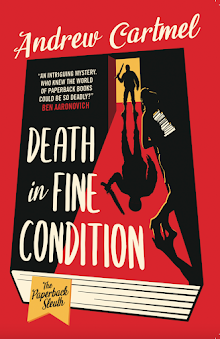 Appointment With Death is the 19th Hercule Poirot novel, published in 1938.
Appointment With Death is the 19th Hercule Poirot novel, published in 1938.It is one of Christie's greatest stories — one of her most original and ingenious set-ups, a truly powerful situation with fascinating, indelible characterisation.
It is not, however, one of her greatest novels, for a very surprising reason — which, like Poirot, I will save for a revelation at the very end of this piece.
 Certainly the novel has a superb, arresting opening with Hercule Poirot in his hotel in Jerusalem, overhearing a fragment of conversation drifting in through his window:
Certainly the novel has a superb, arresting opening with Hercule Poirot in his hotel in Jerusalem, overhearing a fragment of conversation drifting in through his window:"You do see, don't you, that she's got to be killed?"
 "The question floated out into the still night air, seemed to hang there a moment and then drift away down into the darkness towards the Dead Sea."
"The question floated out into the still night air, seemed to hang there a moment and then drift away down into the darkness towards the Dead Sea."Fantastic stuff, and beautifully written. Certainly one of Christie's best ever beginnings.
 And the story just gets better as we're introduced to the Boynton family, a group of young American tourists who are ruled with an iron hand by their elderly "hippopotamus" of a mother.
And the story just gets better as we're introduced to the Boynton family, a group of young American tourists who are ruled with an iron hand by their elderly "hippopotamus" of a mother.Old Mrs Boynton turns out to be a "mental sadist" — she loves inflicting mental torment on her children who, despite being adults, are all still under her thumb.
 They all "depend on her financially" (like the family of Gordon Cloade in Taken at the Flood), but it's more than that.
They all "depend on her financially" (like the family of Gordon Cloade in Taken at the Flood), but it's more than that.Mrs Boynton is like something out of Stephen King, a "hulk of shapeless flesh, with her evil, gloating eyes."
 Christie reveals her to have once been a wardress (i.e. female warden) of a prison. It makes perfect sense. Indeed, it was the ideal job for her — she "became a wardress because she loved tyranny."
Christie reveals her to have once been a wardress (i.e. female warden) of a prison. It makes perfect sense. Indeed, it was the ideal job for her — she "became a wardress because she loved tyranny."Retired now, Mrs Boynton dominates and intimidates her family the way she once did her prisoners. (In fact, effectively they are her prisoners.)
 And she bullies them not physically but psychologically (psychology is a major feature of the novel).
And she bullies them not physically but psychologically (psychology is a major feature of the novel).So it will come as no surprise to you to learn that the old hippopotamus is soon bumped off (by lethal injection — hence the syringes which feature on the various covers here) and Poirot is duly enlisted to bring his "highly specialised services" to bear.
 In his classic manner, he gathers the various interested parties together at the end of the book, and there is considerable excitement and pleasure as he
enumerates the features of the case and ponders who might be
guilty.
In his classic manner, he gathers the various interested parties together at the end of the book, and there is considerable excitement and pleasure as he
enumerates the features of the case and ponders who might be
guilty.The slow, inexorable discussion of the possibilities, and the sifting of the suspects, creates almost unbearable suspense.
 And I never could have guessed the final revelation...
And I never could have guessed the final revelation... But I was, for the first time reading a Christie, disappointed by it.
And that was because I'd previously read the stage play which Christie had adapted from the book — which features a different culprit.
And the solution in the play is truly stunning, reinforcing the central situation and themes of the story in the way that the ending of the novel doesn't.
 I believe Christie herself sensed this weakness and that's why she came up with a better ending for the play — and how.
I believe Christie herself sensed this weakness and that's why she came up with a better ending for the play — and how.Don't hesitate to read the novel of Appointment with Death. It's fine. But once you've done so — or even before you do so — get hold of the play and read that.
The denouement is a knockout. One of her best ever.
(Image credits: The covers of the various editions are from the admirable GoodReads except for the fab front and back cover of the Dell Map Back edition which are from Flickr. and the poster for the play is from Foothill Theatre.)




Michael Winner directed a starry yet terrible film adaptation of this for Cannon in the late '80s. They were clearly trying to restart the franchise (much like their attempt at Superman with the cheapo fourth instalment, Quest for Peace) but it was a real flop. Winner couldn't direct traffic anyway, but there's one crucial scene where it's blatantly obvious who the culprit is because he can't be arsed disguising them adequately.
ReplyDelete